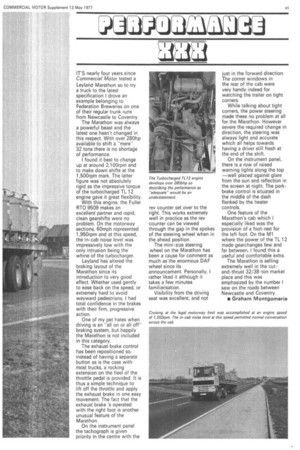IT'S nearly four years since Commercial Motor tested a
Page 204

If you've noticed an error in this article please click here to report it so we can fix it.
Leyland Marathon so to try a truck to the latest specification I drove an example belonging to Federation Breweries on one of their regular trunk runs from Newcastle to Coventry.
The Marathon was always a powerful beast and the latest one hasn't changed in this respect. With over 280hp available to shift a "mere" 32 tons there is no shortage of performance.
I found it best to change up at around 2,100rpm and to make down shifts at the 1,500rpm mark. The latter figure was not absolutely rigid as the impressive torque of the turbocharged TL 12 engine gave it great flexibility.
With this engine, the Fuller RIO 9509 makes an excellent partner and rapid, clean gearshifts were no problem. On the motorway sections, 60mph represented 1,950rpm and at this speed, the in-cab noise level was impressively low with the only intrusion being the whine of the turbocharger.
Leyland has altered the braking layout of the Marathon since its introduction to very good effect. Whether used gently to ease back on the speed, or extremely hard to avoid wayward pedestrians, I had total confidence in the brakes with their firm, progressive action.
One of my pet hates when driving is an "all on or all off" braking system, but happily the Marathon is not included in this category.
The exhaust brake control has been repositioned so, instead of having a separate button as is the case with most trucks, a rocking extension on the heel of the throttle pedal is provided. It is thus a simple technique to lift off the throttle and apply the exhaust brake in one easy movement. The fact that the exhaust brake 's operated with the right foot is another unusual feature of the Marathon.
On the instrument panel the tachograph is given priority in the centre with the rev counter set over to the right. This works extremely well in practice as the rev counter can be viewed through the gap in the spokes of the steering wheel when in the ahead position.
The mini-size steering wheel on the Marathon has been a cause for comment as much as the enormous DAF wheel since its announcement. Personally, I rather liked it although it takes a few minutes familiarisation.
Visibility from the driving seat was excellent, and not just in the forward direction. The corner windows in the rear of the cab were very handy indeed for watching the trailer on tight corners.
While talking about tight corners, the power steering made these no problem at all for the Marathon. However severe the required change in direction, the steering was always light and accurate which all helps towards having a driver still fresh at the end of the shift.
On the instrument panel, there is a row of raised warning lights along the top —well placed against glare from the sun and reflection in the screen at night. The parkbrake control is situated in the middle of the dash flanked by the heater controls.
One feature of the Marathon's cab which I especially liked was the 'provision of a foot-rest for the left foot. On the M1 where the power of the IL 12 made gearchanges few and far between, I found this a useful and comfortable extra.
The Marathon is selling extremely well in the cutand-thrust 32/38-ton market place and this was emphasized by the number I saw on the roads between Newcastle and Coventry.
• Graham Montgonnerie























































































































































































































